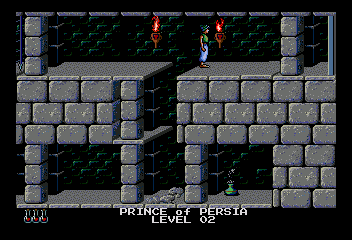New Zealand Story, The (Europe)
Juega New Zealand Story, The (Europe) en línea en tu navegador. Sin necesidad de descargar.
Sobre New Zealand Story, The (Europe) :
.png)
New Zealand Story: The Kiwi's Epic Rescue Mission
New Zealand Story captivates players with its adorable protagonist and challenging gameplay, following the adventures of Tiki the kiwi as he battles through a colorful interpretation of New Zealand to rescue his kidnapped friends. Released in arcades in 1988 by Taito before being ported to numerous home systems, New Zealand Story combines precise platforming with diverse weapons and vehicles to create a deceptively challenging experience beneath its cute exterior. What makes New Zealand Story particularly memorable is its unique progression system—Tiki travels through themed worlds representing different regions of New Zealand, from beaches and forests to mountains and cities, each filled with enemies inspired by local wildlife and mythology but given cartoonish makeovers. The game introduces innovative transportation mechanics as Tiki can commandeer different vehicles including balloons, submarines, and flying saucers, each with distinct control schemes that add variety to the gameplay. Throughout New Zealand Story, players collect power-ups to enhance Tiki's primary bow and arrow weapon with lasers, bombs, and other projectiles, creating strategic decisions about which weapons work best for different situations. The game's apparent simplicity masks a significant difficulty curve, with precise jumps, numerous hazards, and challenging boss encounters that demand quick reflexes and memorization. With its charming presentation, catchy music, and surprising depth, New Zealand Story exemplifies the perfect balance of accessibility and challenge that defined many arcade classics of its era.
How New Zealand Story Hopped From Arcades to Gaming History
New Zealand Story was developed by Taito and first released in arcades in 1988, conceived as part of a wave of cute mascot-driven games that balanced accessible aesthetics with challenging gameplay. The original concept reportedly came after Taito developers visited New Zealand and were inspired by the country's unique wildlife, particularly the kiwi bird that became the game's protagonist. Following its arcade success, New Zealand Story was ported to numerous home systems including the NES, Sega Master System, Commodore 64, and Amiga, with each version adapted to the capabilities of its respective hardware. The home ports varied in accuracy to the arcade original, with some adding exclusive features—the Mega Drive/Genesis version notably included additional levels and a new ending. The game achieved particular popularity in Europe and Japan, where it helped establish Taito's reputation for creating character-driven arcade experiences with substantial depth. New Zealand Story influenced subsequent platformers with its vehicle mechanics and level design philosophy, while Tiki himself appeared in various Taito compilations and crossover games in the decades that followed. Though never achieving the mainstream recognition of contemporaries like Mario or Sonic, New Zealand Story maintained a dedicated following among retro games enthusiasts who appreciated its perfect balance of challenge and charm. Today, the game is considered a classic example of late-1980s arcade design, demonstrating how seemingly simple gameplay could be elevated through thoughtful mechanics, memorable character design, and increasingly complex challenges.
Navigating Tiki's Journey Through New Zealand Story
New Zealand Story's Kiwi-Powered Adventure Elements
- Multiple transportation methods including balloons, submarines, and UFOs with unique control mechanics
- Diverse weapon system with upgradeable bow and arrow plus special weapons
- Colorful stages themed after New Zealand locations with distinct environmental challenges
- Hidden warp doors and secret paths rewarding exploration and experimentation
- Challenging boss battles against larger-than-life animal adversaries
- Underwater sections requiring oxygen management and different physics
- Multiple endings based on player performance throughout New Zealand Story
From Flightless Bird to Airborne Hero
In New Zealand Story, players control Tiki the kiwi through side-scrolling levels filled with platforms, enemies, and environmental hazards. The core gameplay combines precision jumping with ranged combat using Tiki's bow and arrow, which can be upgraded with various projectile types. Movement in New Zealand Story demands precision, as Tiki's jumping physics require careful timing and positioning, especially when navigating narrow platforms or avoiding water hazards (as Tiki can't swim without assistance). Throughout levels, players discover various vehicles that transform gameplay—balloons allow for extended flight but are vulnerable to sharp objects, submarines enable underwater exploration with limited oxygen, and UFOs provide enhanced maneuverability with different control schemes. The game features a health system where a single hit from enemies or hazards results in lost life, creating tension and encouraging cautious progression. Power-ups appear randomly from defeated enemies, including weapon upgrades and temporary invincibility. Hidden warp doors in various stages can help skilled players discover shortcuts or bonus areas. This combination of cute aesthetics with challenging gameplay mechanics makes New Zealand Story a standout among arcade-inspired retro games, demanding mastery of multiple control schemes and quick adaptation to changing circumstances.
 (Beta).png)
.png)
.png)
.png)
.png)
.png)
.png)
.png)
 (En,Fr,De,Es).png)

.png)
.png)